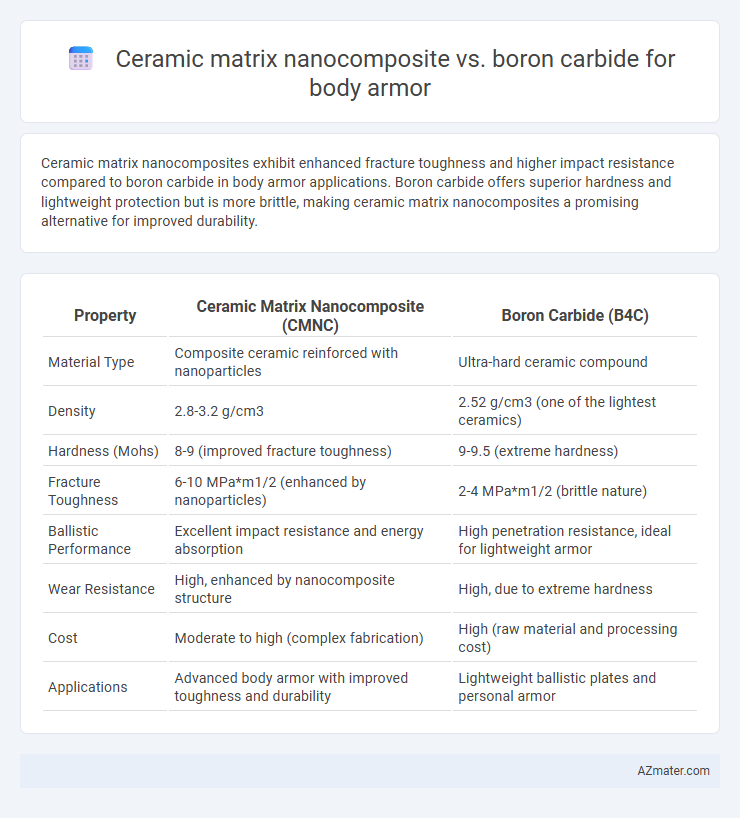Ceramic matrix nanocomposites exhibit enhanced fracture toughness and higher impact resistance compared to boron carbide in body armor applications. Boron carbide offers superior hardness and lightweight protection but is more brittle, making ceramic matrix nanocomposites a promising alternative for improved durability.
Table of Comparison
| Property | Ceramic Matrix Nanocomposite (CMNC) | Boron Carbide (B4C) |
|---|---|---|
| Material Type | Composite ceramic reinforced with nanoparticles | Ultra-hard ceramic compound |
| Density | 2.8-3.2 g/cm3 | 2.52 g/cm3 (one of the lightest ceramics) |
| Hardness (Mohs) | 8-9 (improved fracture toughness) | 9-9.5 (extreme hardness) |
| Fracture Toughness | 6-10 MPa*m1/2 (enhanced by nanoparticles) | 2-4 MPa*m1/2 (brittle nature) |
| Ballistic Performance | Excellent impact resistance and energy absorption | High penetration resistance, ideal for lightweight armor |
| Wear Resistance | High, enhanced by nanocomposite structure | High, due to extreme hardness |
| Cost | Moderate to high (complex fabrication) | High (raw material and processing cost) |
| Applications | Advanced body armor with improved toughness and durability | Lightweight ballistic plates and personal armor |
Introduction to Advanced Materials in Body Armor
Ceramic matrix nanocomposites (CMNCs) offer enhanced toughness and fracture resistance compared to traditional ceramics like boron carbide, making them ideal for next-generation body armor. Boron carbide remains a leading material due to its exceptional hardness and low density, providing effective ballistic protection while maintaining wearer mobility. Advanced materials in body armor increasingly leverage the superior energy absorption and crack deflection properties of CMNCs to improve survivability against high-velocity projectiles.
Overview of Ceramic Matrix Nanocomposites
Ceramic matrix nanocomposites (CMNCs) combine ceramic materials with nanoscale reinforcements, offering superior fracture toughness and enhanced energy absorption compared to traditional ceramics like boron carbide. Their nanoscale phases improve crack deflection and inhibit crack propagation, resulting in higher impact resistance crucial for body armor performance. These properties make CMNCs a promising alternative to boron carbide, providing lighter armor solutions without compromising ballistic protection.
Properties and Structure of Boron Carbide
Boron carbide exhibits exceptional hardness, low density, and high elastic modulus, making it one of the hardest known materials ideal for body armor applications. Its icosahedral crystal structure contributes to superior wear resistance and compressive strength, outperforming many ceramic matrix nanocomposites in ballistic protection. With excellent neutron absorption and thermal stability, boron carbide enhances armor durability under extreme conditions while maintaining lightweight characteristics essential for portable defense systems.
Comparative Mechanical Strength and Toughness
Ceramic matrix nanocomposites exhibit superior fracture toughness and enhanced energy absorption compared to boron carbide, making them more resistant to crack propagation under high-velocity impacts. Boron carbide, while extremely hard and lightweight, tends to suffer from brittle failure due to its lower toughness, limiting its damage tolerance in armor applications. The improved mechanical strength and toughness of ceramic matrix nanocomposites translate into higher ballistic resistance and durability in body armor systems.
Ballistic Performance Analysis
Ceramic matrix nanocomposites offer superior ballistic performance compared to boron carbide due to their enhanced toughness and resistance to crack propagation under high-velocity impacts. The nano-reinforced ceramic matrix improves energy absorption and reduces spallation, resulting in better multi-hit capabilities. Boron carbide, while extremely hard and lightweight, tends to exhibit brittleness, making it less effective in dissipating ballistic energy during penetration events.
Weight and Comfort Considerations
Ceramic matrix nanocomposites offer enhanced toughness and impact resistance while maintaining lower density, resulting in lighter body armor compared to boron carbide composites. Boron carbide excels in hardness and ballistic protection but is relatively heavier, which can reduce wearer comfort during extended use. The improved weight-to-strength ratio of ceramic matrix nanocomposites contributes to better mobility and reduced fatigue in protective gear applications.
Durability and Multi-hit Capability
Ceramic matrix nanocomposites demonstrate superior durability due to their enhanced crack resistance and improved toughness, making them highly effective in withstanding multiple ballistic impacts. Boron carbide, while extremely hard and lightweight, tends to be more brittle, which can reduce its multi-hit capability by increasing the risk of catastrophic failure after the first impact. The nanostructured reinforcement in ceramic matrix composites offers better energy dissipation and maintenance of structural integrity under repeated strikes, providing an advantage in body armor applications requiring reliable multi-hit performance.
Manufacturing Challenges and Scalability
Manufacturing ceramic matrix nanocomposites (CMNCs) for body armor involves complex processes like nanoparticle dispersion and consolidation, posing challenges in achieving uniform microstructures and consistent mechanical properties at scale. In contrast, boron carbide fabrication relies on conventional powder processing and sintering, offering relatively well-established scalability but facing difficulties in controlling grain growth and porosity. Both materials require optimization to balance cost-effectiveness, high-volume production, and performance reliability for widespread armor applications.
Cost-effectiveness and Market Availability
Ceramic matrix nanocomposites offer improved toughness and energy absorption compared to boron carbide, but their higher production costs limit widespread market availability for body armor applications. Boron carbide remains the preferred choice due to its established manufacturing processes, lower cost per unit area, and proven effectiveness in ballistic protection. Market analysis shows that despite advancements in nanocomposite technologies, boron carbide dominates the cost-effective segment of body armor materials.
Future Trends in Body Armor Materials
Ceramic matrix nanocomposites (CMNCs) exhibit superior toughness and enhanced fracture resistance compared to conventional boron carbide, making them promising candidates for next-generation body armor. Advances in nanotechnology enable CMNCs to achieve higher energy absorption and multi-hit capability, addressing limitations of boron carbide's brittleness. Future trends emphasize integrating CMNCs with lightweight fiber reinforcements to develop armor systems offering exceptional ballistic performance and reduced weight for improved soldier mobility.

Infographic: Ceramic matrix nanocomposite vs Boron carbide for Body armor
 azmater.com
azmater.com